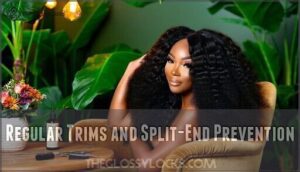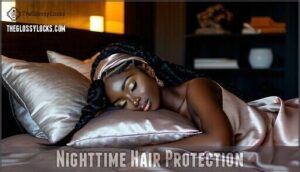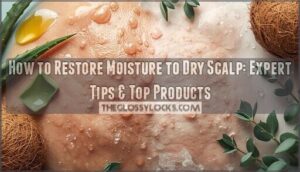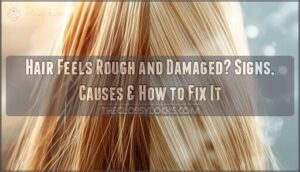This site is supported by our readers. We may earn a commission, at no cost to you, if you purchase through links.
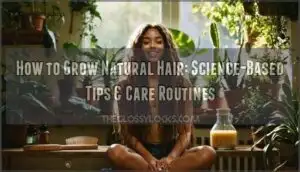
You can’t force hair to grow faster than it wants to. What you can do is stop it from breaking off. Skip sulfate shampoos—they strip everything. Deep condition regularly. Protect your hair at night with a silk scarf or bonnet. Those little habits add up.
Throw in some scalp massage to get blood flowing to your follicles, and you’re not just fixing damage anymore—you’re actually keeping the length you grow.
Once you know how each strand actually works, you stop guessing and start getting real results.
Table Of Contents
- Key Takeaways
- How Does Natural Hair Grow?
- What Causes Slow or Damaged Hair Growth?
- Common Causes of Hair Loss
- Effects of Age and Hormones
- Male and Female Pattern Baldness
- Essential Vitamins and Minerals
- Omega-3 Fatty Acids and Healthy Fats
- Hydration and Water Intake
- Foods That Promote Hair Growth
- Cleansing With Sulfate-Free Shampoo
- Deep Conditioning and Hair Masks
- Regular Trims and Split-End Prevention
- Nighttime Hair Protection
- Can Home Remedies Boost Hair Growth?
- Choosing The Best Products for Natural Hair
- Frequently Asked Questions (FAQs)
- What Are the Best Natural Hair Growth Products?
- Is Hair Growth Affected by Stress?
- Is There a Way to Stimulate Hair Follicles for Faster Growth?
- How long does it take to see hair growth results?
- Can stress permanently damage hair follicles?
- Should I wash natural hair daily or weekly?
- Can tight hairstyles prevent future hair growth?
- Conclusion
Key Takeaways
- Your hair grows roughly half an inch monthly through a genetically programmed cycle—real progress comes from protecting what you’ve already grown rather than chasing miracle accelerators that don’t exist. – Sulfate-free cleansing, deep conditioning treatments, and protective nighttime routines (silk pillowcases, satin bonnets) prevent breakage at the cuticle level, turning damage control into measurable length retention. – Strategic nutrition targeting follicular health—omega-3s, biotin, iron, and vitamin D—fuels the anagen growth phase from within, while topical treatments like rosemary oil and scalp massage boost microcirculation to dormant follicles. – Evidence-based home remedies (coconut oil for protein loss prevention, aloe vera for follicular blockage clearance) require consistent application over 8-12 weeks before delivering visible results—stop the routine, and improvements fade within a month.
How Does Natural Hair Grow?
Your hair growth happens inside the follicle, a tiny organ under your scalp. Each follicle moves through three phases: anagen (active growth), catagen (transition), and telogen (rest).
Understanding how your hair grows starts with the follicle—a vital structure beneath your scalp that cycles through phases of active growth (anagen), change (catagen), and rest (telogen).
Your genetic blueprint determines growth rate, strand diameter, and peak length potential, though environmental factors and follicular health greatly influence whether you’ll achieve ideal results.
The Hair Growth Cycle
Hair grows in cycles, not one continuous stream. Each follicle moves through phases that control whether it’s actively growing, shifting gears, or taking a break.
During anagen—the growth phase—strands push out for anywhere from two to seven years. Then catagen kicks in as the follicle transitions, followed by telogen, a rest period before the whole cycle starts over.
Once you know how these phases work and what determines cycle length, you can adjust your hair nutrition, time your scalp massage routines better, and pick care strategies that actually support follicle health—no matter which stage it’s in.
Understanding these hair phases and cycle length enables you to enhance hair nutrition, scalp massage routines, and hair care strategies that sustain follicle health throughout every growth stage.
Your follicles are basically the foundation of hair growth. When they’re damaged or weak, everything else suffers—growth slows down, hair gets brittle, and you’re left wondering why nothing’s working.
Inflammation, harsh scalp treatments, or just neglecting follicle health can quietly wreck your hair from the root up. You’ll see thinning, more breakage, and slower regrowth when your follicles can’t do their job.
Regular scalp massage, the right nutrients, and a solid hair care routine all help keep follicles strong. Get those fundamentals right, and you’re building better hair health from the ground up.
Think of follicles as the engines of hair growth—when they’re compromised or weakened, your entire growth trajectory stalls. Follicle damage from inflammation, poor scalp treatment, or inadequate follicle care directly sabotages hair regeneration and restoration.
You’ll notice thinning, breakage, and sluggish growth when follicles can’t function optimally. Prioritizing scalp massage, targeted hair nutrition, and consistent hair care routines strengthens these essential structures, securing sturdy hair health from root to tip.
Genetics and Hair Growth Rates
While you can’t outsmart your DNA, understanding hereditary factors enables smarter hair wellness choices. Up to 80% of androgenetic alopecia cases stem from genetic determinants controlling your hair growth patterns, with over 250 identified loci influencing ethnic variations in thickness and speed.
Genetic testing reveals why some experience faster growth—Koreans show 7% quicker rates—while scalp massage and targeted routines work within your unique genetic hair types to enhance follicle performance and combat hair loss.
Understanding the role of hair growth genetics can help individuals make informed decisions about their hair care.
Average Growth Expectations by Demographics
Understanding ethnic growth rates and demographic factors can help you set realistic expectations. Asian hair typically grows fastest at 1.3–1.4 cm monthly, while Caucasian strands average 1.2–1.25 cm and African hair approximately 0.9 cm.
Age-related changes also matter—hair loss affects 50% of men by age 50, and anagen phase duration shortens over time. Geographic variations and genetic influences further shape individual outcomes, making tailored hair care essential.
To better understand these factors, consider the impact of hair growth rates on overall hair health.
What Causes Slow or Damaged Hair Growth?
Your hair’s growth can stall or weaken when follicles face chronic inflammation, hormonal disruption, or nutrient deficiency—each disrupting the anagen phase at a cellular level.
Understanding these mechanisms, from androgenetic alopecia’s miniaturization process to stress-induced telogen effluvium, enables you to reclaim control over your hair’s vitality and reverse damage before it becomes irreversible.
Common Causes of Hair Loss
You’re not just fighting vanity—hair loss strikes deeper. Androgenetic alopecia drives 95% of male cases and affects up to 50% of women, fueled by genetic wiring in your androgen receptor genes.
Autoimmune disorders like alopecia areata ambush roughly 2% of people worldwide, while nutrient deficiencies—histidine in 90% of cases, iron depletion in women—starve follicles from within.
Hormonal imbalance from thyroid dysfunction, PCOS, or menopause triggers telogen effluvium, shedding up to 30% of scalp density. Reclaim control: target the root causes before they hijack your hair restoration journey.
Your daily habits—from what you eat to how you sleep—can either fuel your follicles or sabotage your strands before they ever reach their full potential. Chronic stress triggers telogen effluvium, pushing hair into premature shedding phases. Poor sleep patterns disrupt cellular regeneration at the follicular level. Insufficient water intake compromises keratinocyte hydration, weakening shaft integrity. Air pollution and climate impact deposit particulate matter on your scalp, obstructing ideal hair growth cycles.
Your hair health faces several controllable threats:
- Stress management failures accelerate cortisol-induced miniaturization
- Erratic sleep patterns block nocturnal growth hormone secretion
- Dehydration starves follicles of essential moisture transport
- Environmental toxins suffocate scalp tissue and impair circulation
Incorporate scalp massage into your hair care routine to counteract these lifestyle stressors and reclaim control over your hair growth trajectory.
- Dehydration starves follicles of essential moisture transport
- Environmental toxins suffocate scalp tissue and impair circulation
Incorporate scalp massage into your hair care routine to counteract these lifestyle stressors and reclaim control over your hair growth trajectory.
Effects of Age and Hormones
As the years accumulate, your hormones shift gears—and your hair follicles feel every pivot. Estrogen decline during menopause affects hair density, while thyroid impact disrupts the growth cycle itself. Androgen influence accelerates hair loss in both sexes, disrupting hormone balance and triggering age-related changes that demand hair restoration strategies like scalp massage for hair health.
| Life Stage | Hormonal Shift | Hair Consequence |
|---|---|---|
| Perimenopause | Estrogen drops | Thinning, breakage |
| Thyroid disorder | TSH imbalance | Stunted growth cycles |
| Androgen surge | DHT elevation | Follicle miniaturization |
Male and Female Pattern Baldness
Pattern baldness doesn’t discriminate, but it does follow distinct blueprints depending on whether you’re male or female—and understanding these genetic roadmaps can help you take control before thinning becomes irreversible.
Men commonly experience receding hairlines and crown thinning due to genetic factors and hormonal sensitivity, while women notice diffuse thinning across the scalp.
Hair restoration options range from scalp treatment and hormone therapy to targeted hair loss prevention strategies that address baldness patterns at their root.
Your hair follicles pull nutrients straight from your bloodstream. That means your diet plays a real role in how fast your hair grows, how thick each strand gets, and how healthy your follicles stay.
The right foods can speed up the growth phase, boost keratin production, and fight off the oxidative stress that slows everything down.
Your hair follicles depend on the nutrients circulating through your bloodstream—which means what you eat directly influences growth rates, strand thickness, and follicle vitality.
Strategic nutrition can accelerate the anagen phase, strengthen keratin production, and combat oxidative stress that stalls growth.
Essential Vitamins and Minerals
Five key nutrients determine whether your hair thrives or stalls. Biotin aids keratin production, yet supplementation only helps the genuinely deficient—despite 33.7% of dermatology patients using it. Vitamin D deficiency affects 35% of American adults, accelerating hair loss. Iron deficiency impacts roughly 20% of women, starving follicles of oxygen.
Zinc balances cellular replication within follicles, while vitamins A and C foster growth and iron absorption.
Target dietary requirements first; hair supplements work only when addressing actual mineral deficiency, not as universal solutions.
Your hair follicles need omega-3 fatty acids to build strong strands. Without them, you’re basically trying to grow healthy hair on an empty foundation—no amount of products can fix that gap.
Omega-3 Fatty Acids and Healthy Fats
Think of omega-3 fatty acids as the architectural framework your hair follicles need—without these essential fats, you’re asking your scalp to build strong strands from nothing but hope and shampoo.
Your body can’t manufacture these essential fatty acid benefits on its own, so you’ll need to consume omega-rich foods like salmon, mackerel, walnuts, and flaxseed to nourish your follicles from within.
These healthy hair oils deliver fat-soluble vitamins directly to your scalp, strengthening each strand while promoting resilient hair growth and preventing the brittleness that sabotages your natural hair care efforts.
Hair follicles don’t create their own moisture. They rely on how hydrated your body is to stay elastic, avoid becoming brittle, and support the processes that build keratin.
Hydration and Water Intake
Your hair follicles can’t manufacture moisture on their own—they depend entirely on your body’s internal hydration to maintain elasticity, prevent brittleness, and assist the biochemical processes that drive keratin synthesis.
Aim for consistent daily intake—roughly eight glasses—to enhance fluid retention and hair moisture. Water balance directly influences your natural hair’s tensile strength and growth velocity, making hydration tips vital for strong hair health and maintenance.
Foods That Promote Hair Growth
The foods you choose daily act as cellular fuel for your hair follicles, directly influencing keratin synthesis and growth velocity.
Prioritize omega-rich foods like salmon and walnuts—these healthy fats fortify follicle membranes while vitamin-enriched meals containing biotin and zinc accelerate natural hair growth.
Nutrient-dense diets supplant ineffective hair growth supplements, delivering enhanced hair health and nutrition without synthetic intervention. Your hair treatment starts on your plate.
Your hair won’t transform overnight, but stick with a routine that works with your follicle biology and you’ll see faster growth with less breakage.
How you wash, condition, and protect your hair sets the stage. Get these basics right and your strands can hit their natural length ceiling.
Your hair won’t transform overnight, but a consistent routine rooted in follicular biology will accelerate growth while minimizing breakage.
The right cleansing protocol, conditioning strategy, and protective measures create an environment where your strands can reach their genetic potential—without compromise.
Cleansing With Sulfate-Free Shampoo
Switching to sulfate-free shampoo isn’t just a trend—it’s one of the most effective decisions you can make to preserve your hair’s natural moisture barrier and prevent the mechanical weakening that leads to chronic breakage.
Conventional sulfates strip your scalp of essential lipids, disrupting scalp balance and compromising hair hydration at the follicular level.
Gentle cleansing formulations maintain natural moisture while supporting ideal hair health, creating the foundation for sustainable hair growth without the inflammatory response triggered by harsh detergents.
Once you’ve shampooed, conditioner locks moisture back in and protects against damage.
It’s basically repairing what cleansing just opened up—your hair’s outer layer needs to be smoothed back down.
Think of conditioning as a three-part system that keeps your hair hydrated short-term and long-term:
After you’ve cleansed your scalp and strands, conditioning becomes your strategic defense against moisture loss, mechanical damage, and cuticle deterioration—think of it as sealing the protective barrier that shampooing temporarily disrupts.
Your conditioning protocol should address both immediate and sustained moisture balance through targeted application:
- Rinse-out conditioner smooths cuticles and restores pH balance after cleansing
- Leave-in products provide continuous hydration and thermal protection throughout styling
- Protein treatments reinforce structural integrity when hair shows elasticity loss
This layered approach bolsters natural hair growth by minimizing breakage and enhancing hair health.
Deep Conditioning and Hair Masks
When daily conditioning isn’t enough to reverse damage, your hair needs the intensive repair that deep conditioning treatments and hair masks deliver.
These protein treatments and moisture-rich formulas penetrate your hair shaft, restoring what heat styling and chemical processing strip away.
You’re basically feeding your follicles the hair nutrition they’ve been starved of—think keratin for strength, natural oils for moisture balance, and botanicals that fuel hair growth from root to tip.
Split ends mean the outer layer of your hair has cracked open. Once that happens, the damage creeps up the strand and can undo months of careful growth.
Think of it like a run in pantyhose—it keeps traveling unless you stop it.
Regular Trims and Split-End Prevention
Split ends aren’t just a cosmetic nuisance—they’re a biological alarm signaling that your hair shaft’s protective cuticle layer has fractured, allowing damage to travel upward and compromise months of growth progress.
Regular trims every 8-12 weeks stop this upward breakage in its tracks. Your hair maintenance routine should prioritize split end repair before damage sabotages your natural hair strengthening efforts.
Nighttime Hair Protection
While you’re sleeping, friction from cotton pillowcases can roughen your hair cuticles, leading to breakage, frizz, and moisture loss that undermines weeks of careful daytime care.
Switch to silk pillowcases or satin bonnets to maintain hair hydration and protect your strands throughout the night. You can also try nightly braiding or hair wrapping techniques—these sleep hygiene practices reduce mechanical stress on your hair shaft, supporting consistent hair growth and long-term hair maintenance without compromising natural hair integrity.
Can Home Remedies Boost Hair Growth?
Home remedies won’t magically transform your hair overnight, but science-backed treatments like scalp massage, rosemary oil, and coconut oil can genuinely stimulate follicle activity and create the conditions your hair needs to thrive.
You’ll learn which DIY methods actually work—and which ones are just internet folklore—so you can take control of your growth journey with evidence instead of guesswork.
Scalp Massage Techniques
Massaging your scalp isn’t just a luxurious indulgence—it’s a clinically supported method to stimulate microcirculation around hair follicles and potentially accelerate growth.
Apply gentle pressure using your fingertips in circular motions for five to ten minutes daily, targeting areas where you want to boost growth patterns.
Incorporate massage oils like rosemary or peppermint to boost scalp stimulation while improving blood circulation, supporting your natural hair care routine with this simple yet evidence-backed technique.
Two botanical powerhouses—aloe vera and coconut oil—have earned their reputation in trichology circles for delivering measurable benefits to compromised hair shafts and undernourished follicles.
Both ingredients work differently but complement each other well:
- Aloe benefits: Proteolytic enzymes repair dead skin cells on your scalp, clearing follicular blockages
- Coconut oil: Medium-chain fatty acids penetrate cortical layers, reducing protein loss during washing
- Hair masks: Combining both creates potent treatments for damaged natural hair
- Scalp treatment: Apply aloe gel directly to inflamed or irritated areas
- Hair health and nutrition: These ingredients assist your broader hair growth strategies through improved hydration
- Hair masks: Combining both creates potent treatments for damaged natural hair
- Scalp treatment: Apply aloe gel directly to inflamed or irritated areas
- Hair health and nutrition: These ingredients assist your broader hair growth strategies through improved hydration
Onion Juice and Rosemary Oil
Your scalp’s most controversial allies—pungent onion juice and aromatic rosemary oil—pack sulfur compounds and circulatory-boosting properties that challenge conventional hair growth wisdom.
While onion’s quercetin content aids hair follicle regeneration and rosemary oil rivals minoxidil in clinical trials, you’ll need consistency—applying these natural remedies twice weekly for at least three months before witnessing measurable hair regrowth that defies the skeptics.
A few herbal supplements and natural tonics worth looking into:
Beyond kitchen staples, herbal remedies like ginseng and botanical extracts have earned their place in traditional hair care protocols—but you’ll want to understand which compounds actually penetrate the follicular unit. Ginseng benefits stem from ginsenosides that may stimulate dermal papilla cells, while lemon juice’s acidity can disrupt your scalp’s pH balance despite its vitamin C content.
Consider these herbal supplements and natural tonics:
- Ginseng extract: Applied topically to assist follicular metabolism
- Aromatic oils: Lavender and peppermint show promise in animal studies
- Green tea: Polyphenols may inhibit DHT formation
- Horsetail extract: Silica content assists keratin structure
Your hair maintenance routine should prioritize evidence-backed interventions over trending natural hair care remedies lacking clinical validation.
Effectiveness of DIY Treatments
In truth, most DIY hair masks and homemade shampoos using natural remedies like essential oil therapy deliver modest, temporary results—unless you’re willing to commit to consistent use.
Research shows over 60% of adults have experimented with homemade hair growth serums, but effectiveness drops sharply once your hair routine stops. Natural hair care products require ongoing application to maintain visible improvements, usually lasting only 2–4 weeks post-discontinuation. That’s the trade-off for control.
Picking the right products means knowing how your hair actually works at the cellular level—what’s happening with your follicles and how different ingredients affect them.
Choosing The Best Products for Natural Hair
Selecting the right products isn’t just about reading labels—it’s about understanding your hair’s cellular structure and how formulations interact with your follicles.
With the natural hair care market projected to hit $51.65 billion by 2031, you’ve got more options than ever, but you’ll need to cut through the marketing hype and focus on what actually produces outcomes.
Natural Vs. Conventional Hair Products
Choosing between natural and conventional hair products isn’t just about reading labels—it’s about understanding what your follicles actually need to thrive. Conventional products often contain sulfates and synthetic silicones that strip natural oils, while organic shampoos with certified natural ingredients work with your hair’s biology.
Chemical-free formulations respect the delicate ecosystem of your scalp, supporting healthy hair growth without compromising your beauty and wellness goals. Product certification matters—look for transparent hair product labels that prove authenticity.
Innovations in Plant-Based Formulas
Plant-based formulas are breaking free from the "gentle but weak" stereotype, now delivering clinically measurable results that rival synthetic alternatives. You’re seeing innovations like:
- 2-deoxy-D-ribose: a naturally occurring sugar stimulating blood vessel formation for hair regrowth comparable to Minoxidil
- Sulfate-free cleansers: preserving follicle integrity without stripping natural oils
- Cruelty-free proteins: fortifying hair shafts using vegan keratin alternatives
- Sustainable botanical extracts: delivering concentrated phytonutrients for accelerated growth
- Plant-derived ceramides: repairing cuticle damage at the molecular level
These vegan haircare breakthroughs prove natural conditioners and plant-based shampoos can command your hair’s transformation without compromise.
Market Trends in Hair Growth Products
Right now, the global market for hair growth supplements is exploding—from USD 830.6 million in 2024 to a projected USD 1.94 billion by 2030.
You’re seeing product innovation shift toward multi-ingredient formulas, plant-based hair supplements with biotin and adaptogens, and ecommerce sales driving accessibility.
Consumer trends favor natural hair care and maintenance solutions with sustainable packaging, while Asia-Pacific leads demand for hair growth and restoration technologies.
Know when it’s time to see a specialist:
If you’ve tried every product on the shelf and still aren’t seeing the results you want, it’s time to stop guessing and start consulting a trichologist or dermatologist who can diagnose what’s actually happening beneath your scalp. Professional consultation offers targeted scalp analysis to identify underlying issues like hormonal imbalances, inflammatory conditions, or miniaturized follicles that over-the-counter products can’t address.
When professional hair loss diagnosis becomes essential:
- Persistent shedding lasting beyond three months despite improved hair care and maintenance routines
- Visible bald patches or sudden thinning that suggests autoimmune conditions requiring medical treatment
- Scalp discomfort including burning, itching, or inflammation that home remedies and scalp massage can’t resolve
Hair restoration specialists can recommend evidence-based interventions—from prescription medications to sophisticated therapies—that actually work for natural hair growth.
Frequently Asked Questions (FAQs)
What Are the Best Natural Hair Growth Products?
From within the explosive growth of the natural hair care market—projected to hit $65 billion by 2031—choosing the right products matters.
Look for sulfate-free natural shampoos, nutrient-rich growth oils, targeted scalp treatments, and hair serums with plant-based ingredients that nourish follicles without synthetic chemicals.
Is Hair Growth Affected by Stress?
Stress Hormones boost cortisol levels, which disrupts your hair growth cycle and accelerates shedding. Chronic tension triggers telogen effluvium—pushing follicles prematurely into their resting phase. Combat this through Mindful Practices and Relaxation Techniques that restore Emotional Wellness and enhance Natural Hair Care outcomes.
| Stress Impact | Physiological Mechanism | Hair Care Strategy |
|---|---|---|
| Elevated cortisol | Prolongs catagen phase, shortens anagen | Daily meditation, breathwork exercises |
| Reduced blood flow | Nutrient deprivation to follicles | Scalp massage, cardiovascular activity |
| Inflammatory response | Weakens follicular anchoring | Anti-inflammatory diet, omega-3 supplementation |
| Sleep disruption | Impaired cellular repair cycles | Sleep hygiene protocols, silk pillowcases |
Your hair breaks when mechanical stress overwhelms the shaft’s structural integrity. Think of each strand like a rope—constant tugging, rough handling, and environmental wear weaken the fibers until they snap.
Protecting your hair means working smarter, not harder:
- Gentle Combing with wide-tooth implements on damp, conditioned hair minimizes cuticle lifting and cortical fracture
- Moisture Balance through humectant-rich leave-in treatments prevents desiccation-induced brittleness that precipitates mid-shaft snapping
- Protective Styling reduces manipulation frequency, shielding vulnerable ends from friction and environmental stressors
- Hair Oil Treatment with penetrating lipids (coconut, olive) fortifies the hair shaft, improving elasticity and tensile strength
Regular Scalp Massage increases microcirculation, delivering nutrients essential for vigorous hair growth from the follicle.
When selecting Hair Care Product Recommendations, prioritize formulations free from sulfates and alcohols that compromise the moisture barrier, potentially accelerating hair loss through weakened anchoring. Strategic prevention transforms fragile Natural Hair into resilient, length-retaining strands.
- Hair Oil Treatment with penetrating lipids (coconut, olive) fortifies the hair shaft, improving elasticity and tensile strength
Regular Scalp Massage increases microcirculation, delivering nutrients essential for vigorous hair growth from the follicle.
When selecting Hair Care Product Recommendations, prioritize formulations free from sulfates and alcohols that compromise the moisture barrier, potentially accelerating hair loss through weakened anchoring. Strategic prevention transforms fragile Natural Hair into resilient, length-retaining strands.
Is There a Way to Stimulate Hair Follicles for Faster Growth?
Activating dormant follicles isn’t science fiction—it’s cellular biology in action. Scalp massage increases microcirculation, delivering oxygen and growth factors directly to hair roots. Topical treatments containing naturally occurring compounds like 2-deoxy-D-ribose demonstrate follicle activation comparable to pharmaceutical interventions, promoting hair regrowth through enhanced vascular formation. Strategic scalp treatment targeting follicular metabolism can accelerate natural hair development, though individual responses vary based on genetic predisposition to hair loss.
| Stimulation Method | Mechanism of Action | Expected Timeline |
|---|---|---|
| Manual Scalp Massage | Increases blood flow and oxygen delivery to follicles | 4-6 months for visible density changes |
| 2-Deoxy-D-Ribose Application | Stimulates angiogenesis and follicular metabolism | 8-12 weeks for initial regrowth |
| Microneedling Therapy | Creates controlled micro-injuries triggering repair responses | 3-4 months for measurable hair growth |
| Red Light Therapy (LED) | Energizes mitochondria within follicular cells | 6-8 months for significant improvement |
| Peptide-Rich Serums | Delivers signaling molecules for cellular communication | 10-16 weeks for observable results |
How long does it take to see hair growth results?
Real results take time—most people won’t notice significant length changes until around three months in. That’s because human hair grows roughly half an inch per month, and early gains often go unnoticed until several growth cycles align. Hair Growth Timeline depends on Follicle Stimulation, Scalp Health, and how consistently you maintain your routine.
- First month: Focus on reducing hair loss and breakage rather than expecting visible length
- Months 2-3: Hair Regeneration becomes noticeable as healthier strands emerge from improved follicles
- Beyond 3 months: Growth Rate Factors like genetics, nutrition, and Natural Hair care habits determine your personal timeline
- 6+ months: Sustained language development of your hair care routine yields the most dramatic transformations
Can stress permanently damage hair follicles?
While chronic psychological tension can trigger telogen effluvium—a reversible condition where follicles enter premature resting phases—permanent damage prevention remains achievable through hormone balance restoration and targeted scalp health interventions that foster natural hair resilience.
Stress Effects on Hair Follicle Recovery Potential
Should I wash natural hair daily or weekly?
Consistency is key—your hair porosity determines washing frequency. Low-porosity natural hair thrives with weekly washing to preserve natural oils and scalp balance, while high-porosity hair may require more frequent wash days to maintain hydration and promote healthy hair growth using appropriate hair products.
Can tight hairstyles prevent future hair growth?
Yes—tight hairstyles create excessive hair tension and scalp strain that can damage hair follicles permanently.
Tight braiding, ponytails, and weaving cause traction alopecia, triggering hair breakage and progressive hair loss.
Protect your natural hair by loosening styles and prioritizing gentle hair care techniques that foster healthy hair growth.
Conclusion
Your follicles won’t be rushed—they march to their own genetic drumbeat. Learning how to grow natural hair means playing the long game: fortifying strands with targeted nutrition, shielding them from environmental assault, and locking in moisture through strategic product choices.
Your follicles follow their own genetic timeline—real growth comes from protecting what you’ve already earned, not chasing miracle cures
Break the cycle of damage, and you’ll finally see length retention that lasts. Take control, trust the science, and watch your crown reclaim its throne.
- https://crlab.com/en_en/scientific-area/hair-and-scalp/hair-types-and-morphology
- https://www.poweryourcurls.com/19-jaw-dropping-hair-growth-statistics-market-trends-in-2024/
- https://www.healthline.com/nutrition/foods-for-hair-growth
- https://pubmed.ncbi.nlm.nih.gov/12190640/
- https://cecred.com/blogs/cecred-space/myth-busters-are-protective-styles-good-for-your-hair-health







